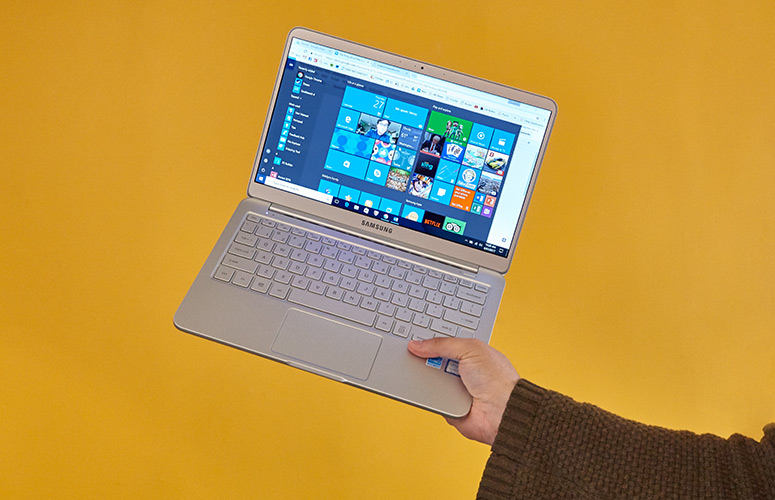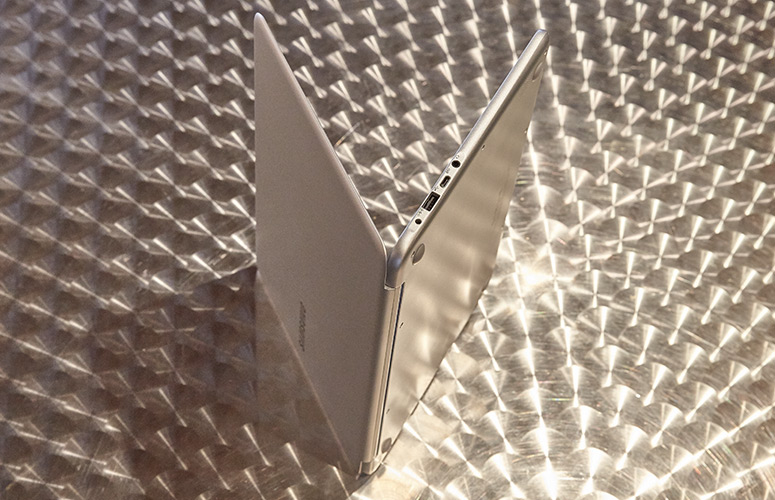Laptop Mag Verdict
The 13-inch Samsung Notebook 9 is an insanely light notebook that's plagued by bad battery life.
Pros
- +
Impossibly light design
- +
Vivid display
- +
Speedy performance
- +
Comfy keyboard
Cons
- -
Short battery life
- -
Chassis exhibits flex
Why you can trust Laptop Mag
How, exactly, did Samsung fit a Windows PC inside the 1.8-pound Samsung Notebook 9 (starting at $999; tested at $1,199)? And not just any computer, but one packing a powerful a Core i7 processor, a comfortable keyboard, plenty of ports and a beautiful 13.3-inch display. If only its battery life and build quality were better, we'd have a phenom on our hands. Instead, the Notebook 9 winds up being a system that's great for travelers who always find themselves near power outlets.
Design: There's such a thing as too light
The Notebook 9 is so thin and light that one of my colleagues exclaimed, "I'm worried I'm going to break it in half, like a Pop Tart!" when they first held it. And while I like the idea of a notebook so lightweight that I can't feel it in my bag, its metal body flexes under pressure more than I'm comfortable with.
The featherweight Notebook 9 weighs a mere 1.8 pounds and measures 0.6 inches thick, making it lighter than the Acer Swift 7 (2.5 pounds; 0.4 inches), the 2016 Apple MacBook (2 pounds; 0.5 inches), the LG Gram (2 pounds; 0.6 inches) and the Dell XPS 13 (2.7 pounds; 0.6 inches).
Samsung placed the Notebook 9's first USB 3.0 port, a USB Type-C port (which supports 4K display output with optional adapter) and a headphone jack on the left side. Over on the right side, you'll find its full HDMI-out, SD memory reader and a second USB 3.0 port. That might not seem like a ton of ports, but it sure beats the USB Type-C-only MacBook and Swift 7.
Display: You'll love the view
The Notebook 9's 13.3-inch 1080p display provides crisp, bright and vibrant images. Watching a Thor: Ragnarok trailer on the notebook, I was impressed by the vivid orange lava, Thor's bright red cape and Hulk's green skin. I also noticed fine details that I hadn't seen in prior viewings on lower-res panels, including the glowing eyes of bodies strapped to underground pillars.
Sign up to receive The Snapshot, a free special dispatch from Laptop Mag, in your inbox.
According to our colorimeter, the Notebook 9 produces 118 percent of the sRGB spectrum. That edges out marks from the Swift 7 and the MacBook and beats the XPS 13. The LG Gram proved it was the most colorful, earning a 135-percent score.
Even better, those colors are also accurate, as the Notebook 9 notched a score of 0.2 on the Delta-E test (where 0 is perfect). That beats the Swift 7, the MacBook, the Gram, the XPS 13 and the 2.4 category average.
The Notebook 9's screen is also plenty bright, emitting up to 308 nits (a measure of brightness). That beats the 295-nit category average and the 271-nit Gram, and it's just a smidge above the 302-nit XPS 13. Brighter panels are found in the 319-nit Swift 7 and the 327-nit MacBook. This brightness enables decent viewing angles, as colors retained their hues at 45 degrees to the left and right.
Keyboard, Touchpad: Good for clicking and clacking
The Notebook 9's full-size keyboard offers a comfortable typing experience. When I tried it out on the 10fastfingers.com typing test, I hit 79 words per minute, a word shy of my 80 wpm average. That performance is owed to the keys' 1.6 millimeters of travel and 69 grams of required actuation force, measurements within our preferred range (above 1.5mm and 60g).
Unlike every other notebook I've ever seen, the Notebook 9 devotes a letter-key's worth of space (the right half of the right Shift) to its fingerprint reader. During my testing, I noted that the speedy sensor makes logging in via Windows Hello a breeze.
The notebook's 3.9 x 2.3-inch buttonless touchpad offers accurate input tracking and a decent feel to each click. It also speedily recognized two-finger swiping and three-finger app-navigation.
Audio: Big sound in a tiny frame
The Notebook 9 provides enough solid sound to fill our large conference room, though you'll need Samsung's utility for optimal audio. Playing Kendrick Lamar's "DNA" on the notebook, I noticed solid bass and crisp drums, but didn't think the vocals were clear enough. This muffled music cleared up by opening the Samsung Setting app, selecting the Music tab and choosing the Music preset.
Performance: Such power for such a light device
Expect solid speed from the Core i7-7500U CPU, 16GB of RAM configuration of the Notebook 9, which enables quality multitasking. I saw no stutter after I split my screen between a 1080p YouTube video and a dozen Chrome tabs (including Slack, TweetDeck and Google Docs). The system continued to move at a brisk pace after I opened a handful of apps, including the Windows App Store, Camera, Photos and Samsung PC Cleaner.
The Notebook 9 scored an impressive 8,410 on the Geekbench 4 general performance test. That beats the 6,993 ultraportable average, the 5,519 from the Swift 7 (Core i5-7Y54, 16GB RAM), the 6,767 from the LG Gram (Core i5-7200U, 8GB RAM), the 7,287 from the XPS 13 (Core i5-7200U, 8GB RAM) and the 6,272 from the MacBook (Core m5, 8GB RAM).
The 256GB M.2 SATA SSD in the Notebook 9 duplicated 4.97GB of multimedia files in 24 seconds, for a speed of 212.1 MBps. That's practically tied with the SSD in the Gram (212 MBps) and faster than the SSD in the Swift 7. We recorded faster speeds from the SSDs in the MacBook and the XPS 13 (both over 300 MBps).
The Notebook 9 turned in a very good time of 3 minutes and 35 seconds on our OpenOffice productivity test, which matches 20,000 names to addresses. That's faster than the times from the Swift 7, the Gram and the XPS 13. The MacBook (3:11) finished in even less time.
The Intel HD 620 graphics card in the Samsung Notebook 9 helped it earn a high mark of 77,846 on the Ice Storm Unlimited graphics test. That's way above the 54,756 category average.
Gamers can play moderately demanding titles on the Notebook 9, as it ran DiRT 3 (at medium graphics) at a brisk 51 frames per second, well-above our 30 fps playability threshold and the 34 fps category average. The Swift 7 and the Gram (31 and 30 fps) both ran the game at smooth-enough rates, while the MacBook and the XPS 13 (27 and 28 fps) failed to meet our standard.
Battery Life: Maybe that's where all the weight went
If you want a computer that goes the distance on a single charge, look elsewhere.
MORE: Laptops with the Longest Battery Life
The Notebook 9 lasted a short 5 hours and 11 minutes on the Laptop Mag Battery Test, which is shorter than the 8:18 category average, and the times from the Swift 7 (7:25), the MacBook (9:38), the Gram (10:15), and the XPS 13 (13:49).
Webcam: Don't expect much
Integrated webcams remind me of $1 pizza slices: sure they do the trick, but nobody's raving about them.
This one did a fine job of capturing my skin tone and the blues of my sweater, but co-workers, monitors and walls in the background appeared blurry and washed out.
Heat: Cold as ice
The Notebook 9 is one cool customer. After we streamed 15 minutes of HD video on the laptop, our heat gun registered acceptable temperatures on its touchpad (78 degrees Fahrenheit), G&H keys (87 degrees) and underside (90 degrees). Each is below our 95-degree threshold.
Software: Galaxy owners will love this
Similar to its Galaxy phones, Samsung peppered the Notebook 9 with its own utilities. You'll probably want to keep Online Support, which hooks you up with Samsung agents. The other neat tools are PC Message for texting and SideSync for transferring files between the Notebook 9 and Galaxy handsets.
PC Gallery syncs photos between the notebook and Galaxy handsets, though Google Photos does that, with free unlimited cloud storage. TeamPL lets you cast your screen with other users, Wi-Fi Transfer allows direct file sharing between machines and Wi-Fi Camera app lets you use your Galaxy phone's camera with Notebook 9. Maybe you can come up with a way to make Wi-Fi Camera app useful, but I can't imagine a scenario. Simple Sharing is a file-transfer tool for those who don't already use Google Drive or Dropbox, or, you know, email.
Samsung PC Cleanup's uninstall programs feature is obviated by Windows 10's Add or Remove Programs, but its options for freeing space by deleting temporary files and unnecessary user files make up for that.
Configuration options: Two versions
We tested the $1,199 version of the 13-inch Notebook 9, which packs a Core i7-7500U CPU, 256GB of M.2 SATA SSD storage and 16GB of RAM. Samsung sells one other model, which costs $999 and downgrades you to a Core i5-7200U CPU and 8GB of RAM.
If you're like me and keep as many apps and browser tabs open for as long as you can, invest that the extra $200 for the memory bump.
Bottom Line
The Notebook 9's heft, or rather lack thereof, is astonishing. Its speedy CPU, comfy keyboard and brilliant display make it great for both work and play. If only it lasted longer on a charge or felt more durable.
You don't need to settle for short battery life, as the $1,199 XPS 13 lasts more than 13 hours on a single charge, though it's not as fast or as light. If you're trying to travel as light as possible, the Notebook 9 is worth a look, but we'd gladly trade a bit more weight and a beefier battery for more endurance.
Credit: Jeremy Lips/LaptopMag
Samsung Notebook 9 (13-inch, 2017) Specs
| Bluetooth | Bluetooth 4.1 |
| Brand | Samsung |
| CPU | 7th-gen Intel Core i7-7500U |
| Company Website | http://www.samsung.com/us/computing/windows-laptops/12-14/notebook-9-13-3---16gb-ram--np900x3n-k04us/ |
| Display Size | 13.3 |
| Graphics Card | Intel HD Graphics 620 |
| Hard Drive Size | 256GB |
| Hard Drive Speed | n/a |
| Hard Drive Type | SSD |
| Highest Available Resolution | 1920 x 1080 |
| Native Resolution | 1920x1080 |
| Operating System | Windows 10 Home |
| Ports (excluding USB) | USB Type-C, Microphone, MicroUSB, Headphone, HDMI |
| RAM | 16GB |
| RAM Upgradable to | 16GB |
| Size | 12.18 x 8.19 x 0.55 |
| Touchpad Size | 3.9 x 2.3 |
| USB Ports | 2 |
| Video Memory | Shared |
| Warranty/Support | 1 Year Standard Parts and Labor |
| Weight | 1.8 lbs |
| Wi-Fi | 802.11ac |
| Wi-Fi Model | Intel Wireless-AC 8260 |
Henry was a contributing writer at Laptop Mag. He penned hundreds of articles, including helpful how-tos for Windows, Mac, and Gmail. Henry has also written about some of the best Chromebooks, and he has reviewed many Apple devices, including various MacBook Air laptops. He is now a managing editor at our sister site Tom's Guide, covering streaming media, laptops, and all things Apple.






